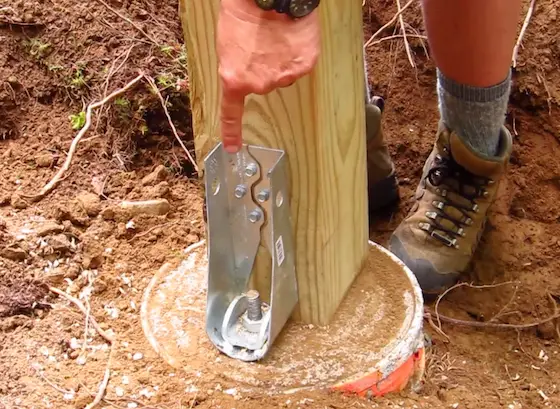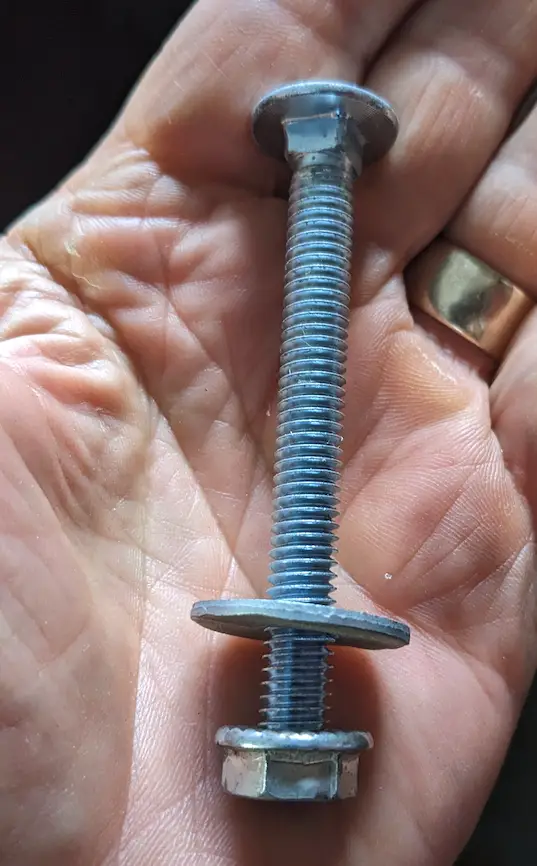Hold Down Anchors and Through Bolts

Hold-Down Anchor and Through Bolts - This is a hold-down anchor. You can use one to make a secure connection between a deck post and a concrete pier. After the photo was taken, the curved washer under the bolt was removed and turned upside down and sideways. These anchors work well to secure a garden shed preventing it from blowing away. Copyright 2023 Tim Carter
Hold Down Anchors and Through Bolts - Strong Connections
I live in rural New Hampshire. When I drive to town, I pass by a house that has a very tall outdoor shed. Every now and then impressive Nor’easters lash us with high winds and rain. We also get our fair share of powerful gales.
After one of these storms hit, I always wonder if the shed is going to be on its side or maybe in the neighbor’s side yard. I say this because I’ve been blown over before carrying a piece of plywood on a windy day.
Have you ever thought about the best way to secure a deck to a concrete pier? What about securing a large barn to a foundation? Tall barns present a huge face to wind and can blow over in a windstorm.
Vertical Hold-Down Anchors
There are all sorts of metal connectors you can use to ensure things you build don’t blow away. I happen to prefer vertical hold-down anchors that are bolted to a substantial concrete pier with a 5/8-inch diameter anchor bolt. Long galvanized lag bolts pass through the metal anchor and are tightened securely to the wood post leg.
It’s really important to use approved galvanized bolts that are rated for direct contact to treated lumber if you’re using these bolts outdoors. When these bolts get wet and the metal is in contact with treated lumber that contains copper as a preservative, a chemical brew is created that can corrode steel and iron that’s not protected. You studied this in high school chemistry class when galvanic reactions were discussed.
Roofing Nails are Not Structural Fasteners
I see mistakes made all the time when I view photographs sent to me by homeowners like you. One big one is using roofing nails to attach joist hangers on decks or inside a home. Roofing nails are not structural fasteners. They work well to secure shingles to roofs or tar paper to wall and roof sheathing but that’s about the extent of their usefulness.
It’s far better to use approved galvanized small structural screws to attach joist hangers to beams and ledger boards. A drill/driver can be used to drive these rapidly. If you’re going to use nails on the joist hangers, be sure to use approved heavy-duty structural nails that have the proper coating to prevent corrosion. You don’t want the nails to rust years from now and have the joist fail.
Structural Screws
Three-inch-long coated screws are easy to find at home centers and hardware stores. These are excellent fasteners to attach two pieces of wood that you never want to come apart. Over time, some nails can lose their holding power as lumber shrinks. A screw that’s not overdriven will hold the two pieces of wood together for many decades.

This is a structural timber screw. Note the bugle-shaped head. It also sports special knerels above the threads that drill a pilot hole for the screw shaft that doesn't have threads. Copyright 2023 Tim Carter
Large-diameter timber screws with large bugle-shaped heads are now mainstream. These can be used much like the lag bolts of old. Some have very aggressive coarse threads and are perfect for securing larger dimensional lumber together.
Lag Bolts
Lag bolts are heavy-duty screws. The usually have a hex head. I feel they're inferior because it's easy to overdrive them. When this happens, they lose a considerable amount of holding power.

This is a standard lag bolt. You'd use a flat washer up against the hex head. These come in a wide variety of diameters and lengths. In a marine environment outdoors, use stainless steel ones! Copyright 2023 Tim Carter
Through Bolts are Best
Through bolts are, in my opinion, the gold standard. A through bolt is different from a lag bolt or large timber screw. The through bolt requires that you drill a hole completely through the two pieces of lumber you want to secure to one another. Lag bolts only require a small-diameter pilot hole. Some timber screws require no pilot hole.

This is an example of a through bolt. They come in a wide variety of diameters and lengths. You must use a washer at the nut end! Copyright 2023 Tim Carter
This method of connecting two things together is so good it's what's been used for well over 100 years. Ships, bridges, structural-steel building skeletons are all held together with through bolts. Years ago they were called rivets. Rivets were used to connect massive plates together for the hulls of ships like the Titanic and Lusitania. But for decades now actual high-strength steel bolts and nuts have been used to connect steel beams together.
The hole diameter should match the diameter of the bolt shaft. This requires you to hammer the bolt through the lumber. Once the bolt passes through the pieces of wood, you slide a flat washer over the threads then rotate a nut onto the threads. A wrench or socket on a ratchet is used to tighten the nut and pull the pieces of wood together.
This makes for a stronger connection than you’d achieve using a lag bolt. Lag bolts can be over-tightened by an inexperienced person. When this happens, they lose a significant amount of holding power. For a through bolt to fail, the entire bolt, washer, nut, or bolt head has to be pulled through the lumber. It’s either that or the bolt has to shear off. Through bolts offer great peace of mind and many structural engineers specify them.
Structural Engineer Inspection
I once had to use 1-inch-diameter through bolts to secure rafter ties at the bottom of rafters on a steep 17/12 pitch roof. The architect had specified these. Little did I know that he had arranged for an inspection by a local structural engineer once I had framed the roof.
One day the engineer showed up at the job site unannounced. I knew him and we were friends. He said, “Tim, do you mind if I borrow two of your adjustable wrenches?” I obliged and he proceeded to back off the nuts on a few random connections. He was testing to see if I had taken a shortcut by drilling a larger hole through the lumber. Trust me, it’s no easy chore to install long 1-inch bolts through a 1-inch hole in southern yellow-pine 2x12s!
I had drilled 1-inch holes and after inspecting about four bolts, he gave me an A+ grade on my framing. Make sure you do the same as I did each time you install through bolts. Don’t be tempted to take a shortcut. If you want to talk to me about structural problems or any other conundrum you face, just go to: https://go.askthebuilder.com/coaching
Column 1536